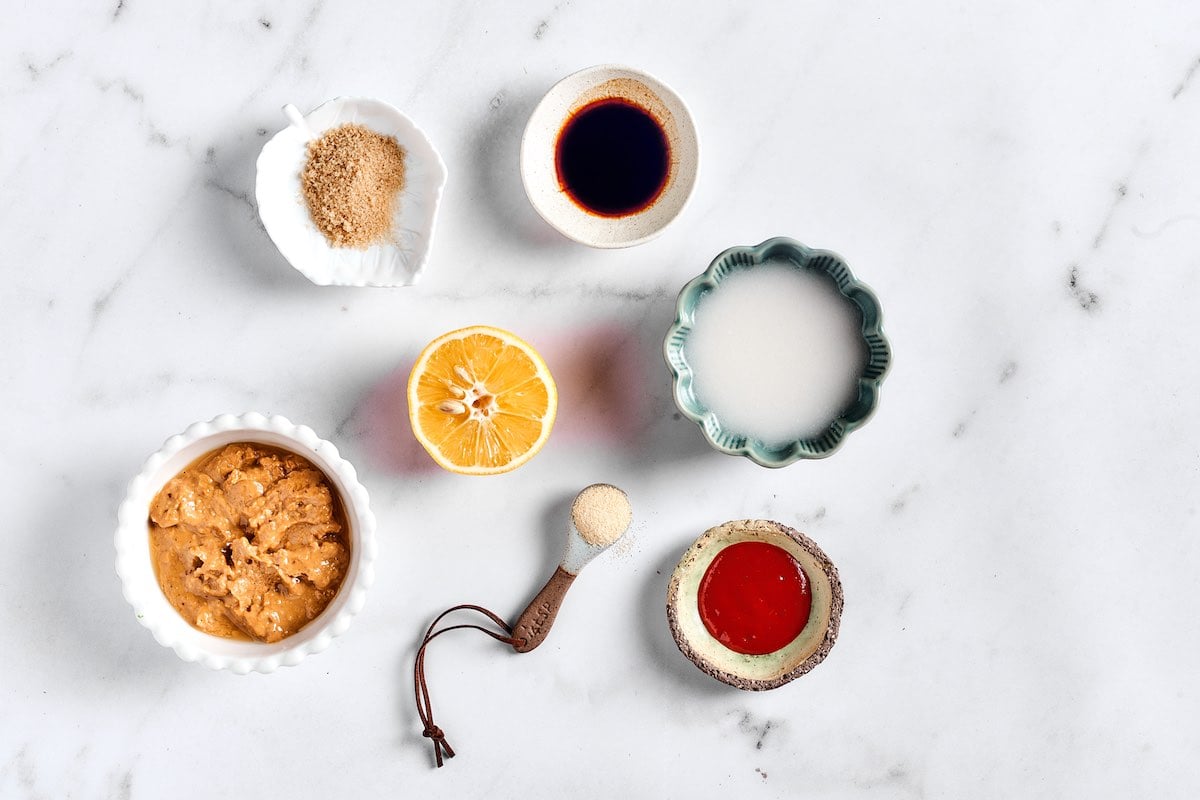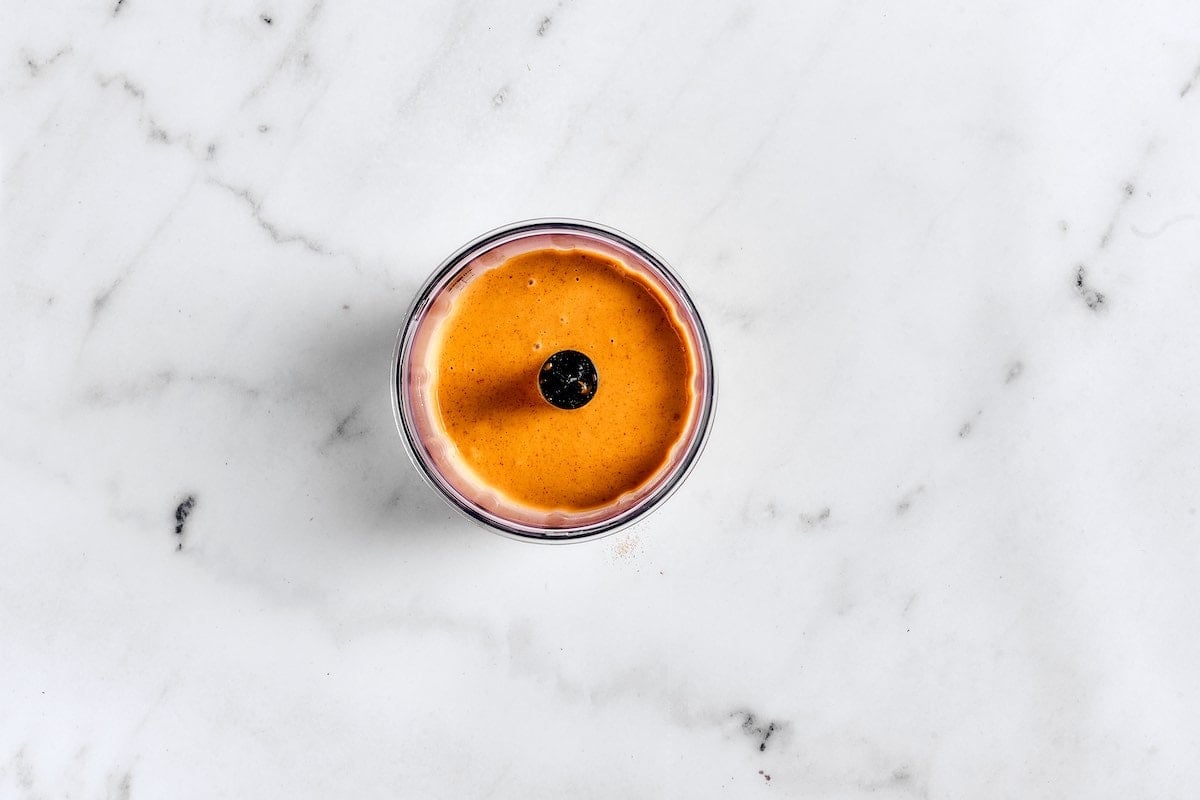Peanut Sauce Recipe
This post may contain affiliate links. See my disclosure policy.
My easy peanut sauce recipe is one of our staple sauces. It’s savory and rich, with an addictive creamy texture. Ready in 5 minutes, pair it with skewered meats, use it as a dipping sauce, or a salad dressing!

No satay chicken is complete without a creamy peanut sauce, and for me, this dish is personal. My dad has a Malaysian background, so I grew up eating peanut sauce with everything from skewered meats to noodles and even as a dipping sauce for summer rolls. Over the years, I’ve tested countless versions to find the perfect balance of salty, sweet, and savory, and this one is my go-to: It needs just seven ingredients and a blender, and in minutes, you’ll have a rich, creamy sauce that’s as versatile as it is addictive. (My partner even swears by it as a sandwich spread!)
Table of Contents
Peanut sauce recipe highlights
- Balanced flavor. Growing up with Malaysian satay peanut sauce taught me it should hit all the notes: salty, sweet, nutty, and savory. This version does exactly that, without being too heavy or sweet.
- Perfect texture. Some sauces turn out pasty or watery. I tested this until I landed on a consistency that’s smooth, creamy, and perfect for dipping OR drizzling.
- Pantry staples only. Seven simple staples you probably already have on hand.
- Versatile. Beyond satay, it’s also a fabulous dipping sauce for air fryer sweet potato fries, a ‘glaze’ for simple proteins, to amp up peanut butter chicken, and even as a sandwich spread.
Key Ingredients

Find the printable recipe with measurements below.
- Peanut butter. Smooth and creamy gives the silkiest texture, though crunchy works if you like extra bite. The most important thing is to use 100% natural peanut butter with no added sugar or salt- I’ve tested this with sweetened brands, and the sauce becomes far too rich.
- Soy sauce. This brings out the salty, savory notes. Regular soy sauce works best, but Tamari or gluten-free soy sauce is an excellent alternative I often use.
- Ketchup or chili sauce. Ketchup keeps it mild and kid-friendly, while chili sauce gives it the authentic satay-style kick. Sometimes I blend the two for balance.
- Sesame oil. A little goes a very long way, but it’s essential for that nutty depth of flavor you find in most Malaysian and Thai peanut sauces. In culinary school, I learned to measure oils like this sparingly- too much can overpower everything.
- Ginger. Always fresh and grated. I’ve tested powdered ginger, and it makes the sauce taste flat compared to the brightness of the real thing.
- Sugar. White sugar dissolves the fastest, but brown sugar adds a subtle caramel undertone. Both work- it depends on whether you want clean or deep sweetness.
- Coconut milk. My go-to for thinning and creaminess. Water works in a pinch. For a lighter option, I’ve also tested oat milk with good results.
Peanut butter substitutes
If you can’t use peanut butter, this sauce works beautifully with other nut or seed butters. I’ve tested it with almond butter (slightly sweeter), cashew butter (mild and creamy), sunflower seed butter (nut-free option), and even tahini for a more earthy flavor. Whichever you choose, ensure it’s natural and unsweetened so the sauce remains balanced.
How to make peanut sauce

Step 1- Blend. Combine all the ingredients in a high-speed blender and blend until smooth. If the sauce is too thick, add some coconut milk or water to thin it out.

Step 2- Serve. Transfer to a serving bowl and serve immediately.
Chef tips for perfect peanut sauce
- For a thicker sauce: Gently simmer it in a saucepan over low heat. As the liquid evaporates, the sauce naturally thickens.
- Rest before serving: Letting the sauce sit for 10-15 minutes allows the flavors to meld together- it tastes noticeably better.
- If the sauce separates: Don’t panic. Just add a splash of water or coconut milk and whisk vigorously until it comes back together. (This is a common mistake I see when readers use refrigerated peanut butter straight from the jar.)
- Blender vs. whisk: I prefer using a blender for the smoothest finish, but you can whisk by hand if you’ve got strong forearms.
- For salad dressings: Add extra coconut milk or water to thin it out. I usually make one batch, then portion half for satay and thin the rest for salads during the week.
Frequently asked questions
They’re very similar, but not exactly the same. Satay sauce is a type of peanut sauce traditionally served with skewered meats in Malaysian and Thai cooking. Peanut sauce can be used more broadly- for salads, spring rolls, noodles, or as a dip.
Yes! In fact, I often do it the night before serving. Resting allows the flavors to meld, and the sauce tastes even better. Simply whisk it before use, as natural separation may occur.
Store it in a sealed glass jar in the fridge for up to one week. For longer storage, freeze it in ice cube trays, then transfer the cubes to a freezer bag. They’ll keep for up to 2 months. I prefer this method because you can defrost exactly what you need without wasting a batch.
Definitely. Add chili paste, red pepper flakes, or even sriracha to taste. When I make it for my family, I usually make it mild, but for myself, I’ll add at least 1-2 teaspoons of chili paste for that authentic satay-style kick.
As written, it’s not because of the soy sauce. But swap in tamari or coconut aminos and it becomes completely gluten-free. I’ve tested both, and the flavors stay delicously balanced.

More Asian sauces to try

Easy Peanut Sauce Recipe
Video
Ingredients
- 1/2 cup peanut butter
- 3 tablespoons soy sauce
- 1 tablespoon ketchup or chili sauce
- 2 tablespoons sugar
- 1 1/2 teaspoons sesame oil
- 1 inch ginger minced
- 2 tablespoons coconut milk or water
Instructions
- Add the peanut butter, soy sauce, ketchup, sugar, sesame oil, ginger, and coconut milk to a high-speed blender or food processor and blend until smooth.
- Transfer to a serving dish ans serve immediately.
Notes
- For a thicker sauce: Add it to a saucepan and heat it on low-medium heat. The sauce will thicken as some of the liquid evaporates.
- Peanut butter substitute: Almond butter, cashew butter, sunflower seed butter, or tahini.
- More flavor: If you have time, rest the sauce for 15-20 minutes before serving.
- Leftovers: Keep in the fridge for one week.
Nutrition
Originally published October 2023, updated and republished August 2025














Made this the other night. Easy & my family loved it! Thank you Armen.
Just made this- incredible!!!